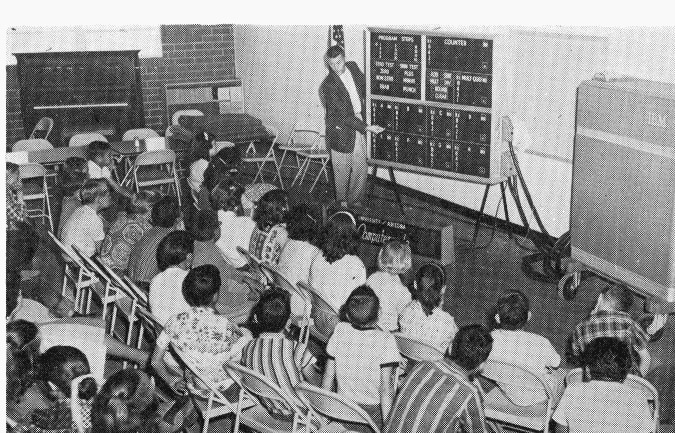|
Project Computercade |
|
John Featherston demonstrates
arithmetic to Village Meadows students using IBM computer. Sponsored by
the University of Arizona, the Computercade has had excellent reception
wherever given.
|
|
The
mushrooming of large digital computer installations within the last decade
has solved a great many computing problems in science and industry, but it
has created at least one new problem. The
numerous popular accounts of these machines give glowing and often
accurate descriptions of the remarkable tasks performed, though seldom of
the method actually used by the machine. It
would be expected that this favorable publicity and public acceptance of
these machines would result in an increased interest in applied
mathematics as a career on the part of high school and college students.
Actually, the effect has been slight and often reversed. The
reason for this becomes clear when considered from the student viewpoint.
The student is impressed by accounts of ultra high-speed, complex machine
operation, but this often seems a subject far removed from his or her
everyday mathematics class. It
could even seem impractical It
does not require much experience with these machines to realize that the
opposite is the case. The real limitation on machine accomplishment is set
by the availability Competence
in this field is not gained as the result of a single course, but comes as
the result of a long term interest in and study of applied mathematics.
The benefits from an ever increasing use of mathematics five to 10 years
hence depends in a large measure on the interests and attitudes of
today's Not
only is he or she the potential programmer, but equally important, they
are certainly the future businessmen, chemists, bankers, surveyors,
clerks - in
short, the future users of computing
systems. A Proposed Solution The
solution to the problem is quite simple, at least in principle. The high
school student must be shown that 1.
The impressive feats of large computers are really the end result of the
machines' performance of a series of basic arithmetic steps. 2.
These individual steps are exactly those being presented in the students'
present mathematics classes. 3.
High school math courses followed by university work in applied
mathematics can be stepping stones to a rewarding career. A
preliminary study of the problem has shown that a series of
demonstration lectures presented at high school class assemblies
throughout the state could be most effective if an actual working computer
could be demonstrated. The machine would have to be large enough to be
representative of modern computers. The actual arithmetic procedures would
have to be visible to the audience. The
purpose of the program would be to show the student that modern
mathematics is useful, challenging, and above all, understandable. The Computercade A
50 minute lecture demonstration entitled "Adventure With
Numbers" was prepared featuring actual operation of the IBM type
604 electronic computer. This machine was chosen because it is the most
widely used of present computers. It is a medium size high speed machine
which has been provided with special features for demonstration
purposes: 1.
It can be operated at speeds so slow that the lecturer can describe the
individual steps of the solution as they occur. One typical problem
requires 12 minutes when solved in this manner. 2.
The status of each part of the machine is visible to the audience at all
times. This is made possible through the use of a special display system
which has been developed at the University of Arizona. 3.
The machine can then resolve 4.
The entire equipment is transportable by truck. The
program is supported by the University to further an understanding of the
ever increasing importance of modern mathematics and machines, as well as
the also increased requirements this places on the student interested in a
career in this field. * * * A
thing done right today means ARIZONA
ENGINEER & SCIENTIST
Aug. 1960
|
| SMECC Note..... We would just love to find this computer if... it still exists out there somewhere! - Ed Sharpe |

